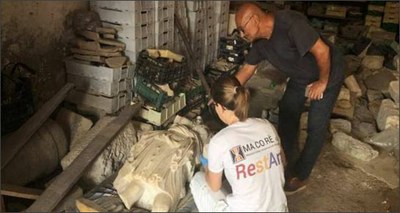Cultural heritage: Robotic system with laser scanner to reassemble fragmented statues
14/10/2021
 A robotic system, equipped with a laser scanner to help restorers reassemble fragmented statues, was conceived and patented by architect Pietro Nardelli as part of RestART [1], a project funded by the EU and the Lazio Region comprising the restoration company Ma.Co.Rè srl jointly with ENEA -which validated the technology- the National Roman Museum and the Central Institute of Restoration of Rome.
A robotic system, equipped with a laser scanner to help restorers reassemble fragmented statues, was conceived and patented by architect Pietro Nardelli as part of RestART [1], a project funded by the EU and the Lazio Region comprising the restoration company Ma.Co.Rè srl jointly with ENEA -which validated the technology- the National Roman Museum and the Central Institute of Restoration of Rome.
So far, RestART has been applied to complex restoration interventions, including the reassembling of the statue of Diana the Huntress from the Roman age at the Pio Capponi Civic Archaeological Museum in Terracina (Lazio), in collaboration with the Superintendence of Archeology of Fine Arts and Landscape for the provinces of Latina, Frosinone and Rieti and the Municipality of Terracina.
"This technology allows to solve the frequent problems that lie in handling, identifying and reassembling fragments, drilling perfectly coaxial and even multiple holes with high levels of accuracy, safely and with the minimum impact on the artwork”, architect Pietro Nardelli explained.
The initial idea for the project dates back to 2017, during the restoration and reassembly of a large Roman marble statue of a togatus. "The severe crack pattern, combined with the considerable weight of the fragments, caused several problems and technical inconveniences in the handling, re-joining and pivoting phases.
Hence the idea of developing an innovative solution to facilitate and improve the restorer's work ", said Nardelli, who conducted the intervention with the company Ma.Co.Rè, on commission by the Diplomatic Protocol of the Republic and under the high surveillance of the Superintendence of Archeology, Fine Arts and Landscape of Rome, at Villa Madama in Rome.
"This technology allows to address the operational difficulties inherent in the use of structural pins in fragmented, small to large sized stone works, but it cannot and does not want to replace the restorer who is in charge of the whole process", Nardelli said.
The main components of the “RestART system” are: a numerically controlled machine with a robotic arm fitted with a drill integrated with an innovative cooling system; a handling software; a suction and recovery system of the original powders that can be reused during subsequent grouting operations; a set of specially created tips; a silenced compressor; a 3D laser scanner and related management software; various lifting and handling equipment for the works and the machinery.
ENEA performed the scientific validation of the system RestART through control tests on a shake table at the Casaccia Research Center (Rome). “We applied increasing shaking intensity to simulate the effects generated by major earthquakes or by high-speed transport on an extremely bumpy road”, explained Ivan Roselli of the ENEA Laboratory of Technologies for the Dynamics of Structures and the Prevention of Seismic and Hydrogeological Risk. "The results of the tests have overall shown that, compared to other methods used so far, the RestART system is more effective and capable of contributing to the technological advancement of conservation science", concludes Roselli.
For more information please contact:
Pietro Nardelli, p.nardelli@tiscali.it
Ma.Co.Rè. srl, info@macore.it
Ivan Roselli, ENEA – Laboratory of Technologies for the Dynamics of Structures and the Prevention of Seismic and Hydrogeological Risk, ivan.roselli@enea.it
Video: ENEA Channel - RestART, innovazione tecnologica per i beni culturali
